
Texas Wildlife Research Program
Pittman-Robertson Grant Highlights
Each year, the TPWD Wildlife Research Grants program awards between $1 and $2 million in federal Pittman-Robertson Act funds for research on Texas’ native wild birds and mammals. This process starts with an annual review by Wildlife Division staff to identify our current, greatest research needs for managing these species. Based on that review process, we then post requests for proposals online for those research needs, and the Wildlife Division follows a competitive review process to award project proposals submitted by qualified Universities or non-governmental organizations. Below are the highlights of projects awarded over the last 7 annual funding cycles of the program (from fiscal year 2019 onward).
Fiscal Year 2021
Evaluating the risk of Mycoplasma transmission from Aoudad to Bighorn Sheep
Principal Investigators: Walter Cook — Texas A&M University AgriLife Research
Caleb Phillips — Texas Tech University
TPWD Project Coordinator: Froylan Hernandez
Status: Completed
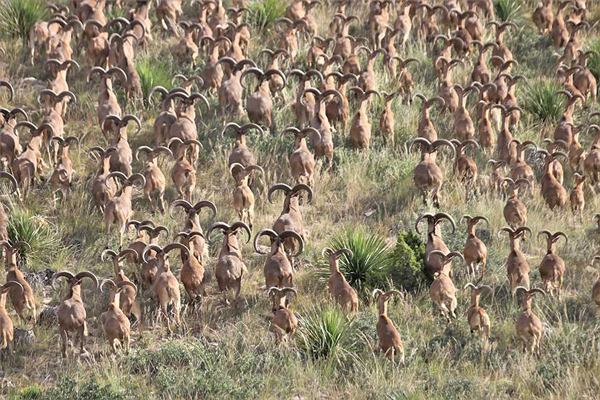
Large aoudad herd
Project Summary: Conserving bighorn sheep (Ovis canadensis) in their native range is challenged by pneumonia epizootics. Mycoplasma ovipneumoniae and Pasteurellaceae family bacteria are strongly implicated in these epizootics. Domestic sheep (Ovis aries) and domestic goats (Capra aegagrus) frequently carry these agents and often cause bighorn sheep epizootics. However, the southwestern United States and northern Mexico host feral populations of aoudad (Ammotragus lervia). Aoudad are native to the Barbary coast of northern Africa and were introduced to the United States in the 1950s to provide hunting opportunities. Their habitat and diet requirements are seemingly similar to those of desert bighorn sheep. Further, aoudad are within the Caprinae subfamily, within which most species are competent carriers of respiratory pathogens. Wildlife managers suspect that aoudad may negatively impact bighorn sheep populations through competition and potential disease transmission. To address these concerns, the investigations focused on the host competency of aoudad, their ability to transmit important respiratory pathogens to bighorn sheep and the clinical pathological effects of these agents in aoudad. These questions were addressed through a two-phase study.
In phase 1 (study not funded by TPWD Wildlife Research Grants funding), aoudad were experimentally inoculated with leukotoxigenic Pasteurellaceae and/or Mycoplasma ovipneumoniae. Results from this study along with a lack of observed pneumonia outbreaks in aoudad across their feral North American range, indicated free-ranging aoudad are relatively resistant to pneumonic pathogens that are fatal to bighorn sheep. Thus, aoudad appear to be a respiratory pathogen transmission risk to bighorn sheep without being themselves highly susceptible to pneumonia epizootics.
For phase 2 (funded by TPWD Wildlife Research Grant), 20 bighorns (10 Male, 10 Female) were captured on Elephant Mountain WMA, Brewster County, TX, and translocated to a holding facility at Mason Mountain WMA (MMWMA), Mason County, TX. After a 20- to 30-day acclimation period, 12 aoudad from a local source (high-fence facility) were introduced into the MMWMA holding facility. The study involved exposing bighorn sheep to indirect and direct contacts with aoudad experimentally infected with leukotoxigenic Pasteurellaceae and/or Mycoplasma ovipneumoniae. Of particular interest was investigating whether sharing a common water source was an important indirect contact type for interspecific transmission. Aoudad transmitted respiratory pathogens intra and interspecifically indirectly (shared water) and directly. Bighorn sheep contacting infected aoudad had moderate to rapid pathogenesis and mortalities. However, aoudad experienced no fatal pneumonia and had mild disease without gross respiratory lesions. Importantly, this study demonstrated that some aoudad carry Mycoplama ovipneumoniae for longer periods of time than others. While some aoudad cleared the infection by 155 days after exposure, others carried the agent 211 days after exposure when the study was terminated. If given more time, these individuals may have continued shedding Mycoplasma ovipenumoniae. This suggests that not all aoudad are of equal transmission risk to bighorn sheep and that transmission among aoudad may be complicated by individual heterogeneity.
Overall, aoudad pose a conceptual disease threat to bighorn sheep and recommendations for future research include investigating: 1) the virulence, transmissibility and sources of different Mycoplasma ovipneumoniae strains in aoudad, 2) how shared water sources may serve as a transmission risk and impact herd-level diagnostics, 3) how aoudad may directly and indirectly affect bighorn sheep social contact networks, 4) the efficacy of various diagnostic assays in free-ranging aoudad and 5) the environmental and demographic drivers of pathogen exposure in aoudad populations.
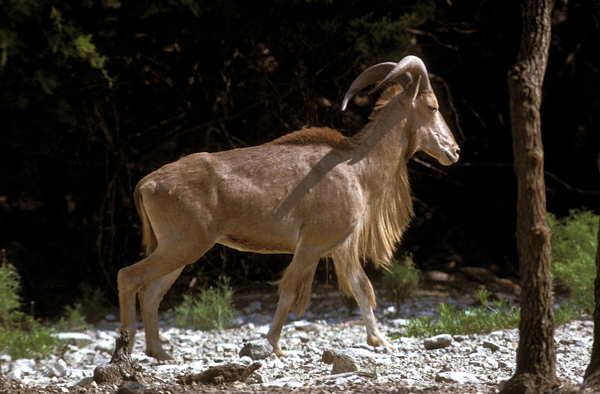
Aoudad male
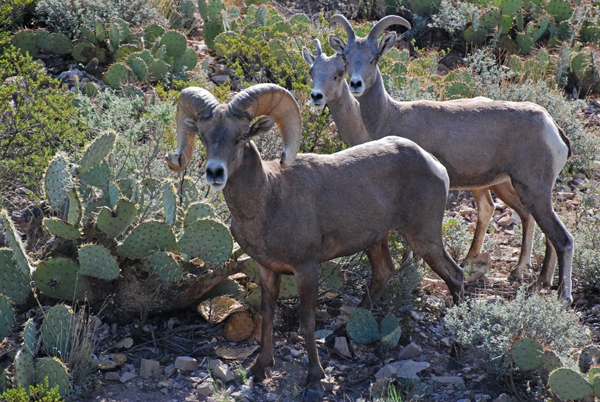
Bighorned sheep
Application of UAV thermal imagery to survey Wild Turkey populations
Principal Investigators: Michael Byrne — University of Missouri
TPWD Project Coordinator: Jason B. Hardin
Status: In Progress
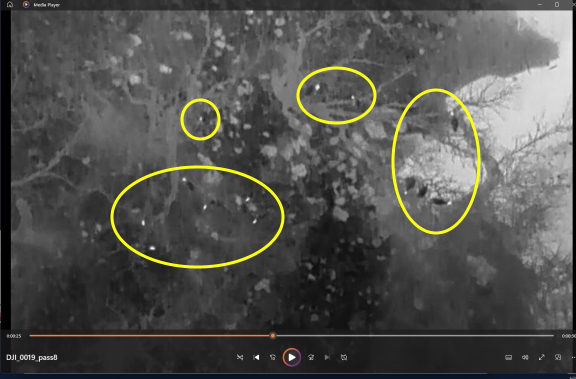
UAV-FLIR flights over GPS-marked wild turkeys and unmarked vultures
Project Summary: Despite the importance of wild turkeys as a game species, there is no widely accepted methodology to estimate wild turkey population densities in an unbiased manner over spatial scales relevant to management. UAV-FLIR flights over GPS-marked wild turkeys and unmarked vultures were conducted during the winters for 2021 and 2022 in TPWD Wildlife Division Districts 3, 5 and 6. Wild turkeys were visually detected on 84.6% of passes and vultures were visually detected on 100% of passes. In 2021, wild turkeys were detected on 58.3% and 89.3% of passes in the Rolling Plains and Cross Timbers ecoregions, respectively. GPS malfunctions may have reduced observability in the Rolling Plains in 2021. In 2022, wild turkeys were detected on 86.3% and 91.7% of passes in the Post Oak Savannah and Pineywoods ecoregions, respectively. Taller and more dense forest cover and smaller flock sizes relative to the Rolling Plains and Cross Timbers makes observability more difficult in our more eastern study sites. Wild turkeys were more visually distinct in lower temperatures, likely because of greater thermal contrast between turkeys and background objects and in lower relative humidity. Wild turkeys reacted more frequently to the drone flights in the Rolling Plains and Cross Timbers regions. However, no birds were observed to flush in response to the drone’s presence. Reactions occurred about twice as frequently during the early flights relative to later flights. Similar wild turkey reactions were rarely observed during flights in the Post Oak Savannah and Pineywoods. The difference in reactions between regions may be a result of differences in vegetation as roost trees in the Rolling Plains and Cross Timbers were shorter and less dense than those in the heavily forested Post Oak Savannah and Pineywoods regions.
Comparing detectability and efficiency of multiple methods for surveying rails
Principal Investigators: Christopher J. Butler — University of Central Oklahoma
TPWD Project Coordinator: Trey Barron
Status: In Progress
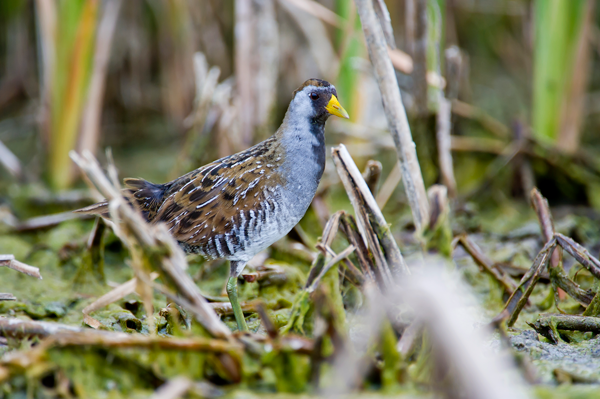
Sora rail bird
Project Summary: Rails are a secretive group of marshland birds that are challenging to detect and see. As wetland obligates, their presence (or absence) on the landscape can be indicative of ecosystem quality and structure. In order to assess rail presence, a methodology that maximizes detection probability for these inconspicuous species would lead to reduced costs for long-term monitoring. We studied six rail species along the Texas Gulf Coast, three that spend their winter season here (Virginia Rail, Yellow Rail and Sora) and three which are present year-round (Black Rail, Clapper Rail and King Rail). In order to assess the best methodology for each species, we monitored these species from 2022-2023 using active methodology (vocalization call-response and thermal drone flights) and passive methodology (trail cameras and passive acoustic monitoring using autonomous recording units). Our Texas sites included: Galveston Island State Park, Justin Hurst Wildlife Management Area, Mad Island Wildlife Management Area, Guadalupe Delta Wildlife Management Area and Mustang Island State Park.
Our 2022 field season resulted in 96 Black Rail, 19 Yellow Rail, 135 Sora, 21 Virginia Rail and 396 King/Clapper Rail call-playback detections across our study sites. Out of 114,553 trail camera photos, we captured a total of 1786 rail photos of all species except for Yellow Rail. Autonomous recording units recorded 5/6 of our target rail species and using occupancy modeling we determined detection probabilities for late season (spring and summer) Sora (47.4%), Black Rail (27.9%), Yellow Rail (0.3%), King/Clapper Rail (70.6%) and Virginia Rail (0.0%). Preliminary drone flights resulted in successful detections of all species, and a recent proof-of-concept is published in "Drone Systems and Applications" as of June 2023. Our 2023 field season is currently ongoing with results expected by the end of the year.